by Adam Rothstein
Recently, the Portland Occupier published an article entitled “Nonviolence Still Wins the Public,” that included a historical list of non-violent protests, intending to highlight how the peacefulness of protesters, especially in the face of violent persecution, won the day for various social movements. This was a very selective history that borders on the disingenuous.
In addition, this context-free history is problematic because this misrepresented history is used to promote a twisted argument currently echoing throughout the Occupy movement, that portrays a strict interpretation of non-violent activism as the only possibly successful method of social change, and therefore, the only one the Occupy movement should consider. The threads of the argument and sub-arguments run like this:
- 1. Property destruction is a form of violence.
- a. Property destruction is aggressive.
b. Property destruction hurts individuals.
c. Property destruction is dangerous.
2. Property destruction, as violence, is bad because it brings police violence, which quashes protests.
- a. The police respond to violence with violence.
b. The police will only ever respond to violence with violence.
c. Police violence hurts protests.
d. The police desire property destruction to respond to, so much that they are willing to use provocateurs to cause it.
3. Property destruction, as violence, is bad because it alienates the masses from movement.
- a. The masses think that property destruction is a form of violence.
b. The masses respond to peaceful protest only.
c. The masses only march when there is no police repression.
d. The masses are most moved by compassion.
4. Because the above facts are universal, or at least universal everywhere in America, the only possible successful American social movement must reject property destruction.
- a. A successful protest must be a mass protest.
b. A successful protest must be a morally upright protest.
c. A successful protest must be unified across a particular nation/state geography.
d. A successful protest must be unified across culture.
5. Because the above facts are universal, or at least universal everywhere in America, the only possible successful American social movement must suffer violence without responding in kind.
- a. A morally upright protest must act morally all of the time.
b. Martyrdom is the most powerful moral political tool.
c. The most heroic form of martyrdom is martyrdom resulting in death.
d. Marytrdom that ends in death is the most worthy of causes.
Not every proponent of strict non-violence agrees with all of these arguments. But, from listening to a long litany of criticisms of property destruction, one can hear all of these arguments.
Each of these arguments is false. Let’s look at the actual history of protests, as misappropriated by the former article, and attempt to fill in the context, so we might understand that these five arguments are wrong.
Correcting the History
“Just as in the first days of the Arab spring revolt, [in 1989] thousands of Czechs faced a well-armed, riot-trained, and brutal police force ready to do mayhem and murder. But the nonviolent response stunned them because it was totally unexpected.”
In the “early days of the Arab Spring”, Egyptians fought off gun-wielding police using rocks and molotov cocktails. Even though this was only a year ago, many Americans choose to remember it as a “non-violent” protest. It was only because of the tireless efforts of protesters returning stones and firebombs thrown by the pro-regime supporters and undercover police, that the protesters were able to stay in Tahrir Square, and the large masses of peaceful protesters were about to return.
“In Czechoslovakia a massive nonviolent protest in 1968 fizzled out, but twenty-one years later, on November 17, 1989, a spontaneous upsurge against Soviet occupation turned into the largest demonstration in the history of the country.”
The “earlier non-violent protest” in 1968 in Czechoslovakia during the Prague Spring: a period of liberalization begun by the government. The liberalization was opposed by the Soviet Union, and in response, Warsaw Pact nations invaded Czechoslovakia. This protest, therefore, was not so much a protest, as a defense against a Soviet invasion, which included riots, graffiti and violence.
The Velvet, or Gentle Revolution, on the other hand, was successfully peaceful, because it faced no forceful opposition. After an initial police riot on November 17th, the authorities never gave orders for the police to attack the demonstrators, and so there was no need for property destruction or self-defense.
“Western history is full of failed revolts of peasants bearing clubs and pitchforks—usually over starvation or taxes—being mercilessly smashed by a king’s or emperor’s troops using swords and guns, crucifixions or heads on pikes by city gates. But when they are unarmed and nonviolent, the enforcers are branded as brutes, the dead and injured as heroic and worthy of statues or world-famous paintings. For example, in Manchester, England back in 1819, nervous city officials ordered 1,500 Waterloo cavalry veterans to use sabers, gun butts, and horses to attack a Sunday afternoon family crowd of 50,000 gathered to hear five speakers advocating voting rights for commoners.”
The effect of the Peterloo Massacre was not to enact the reforms the protesters were wanting, but actually to bring an even larger crackdown on the media and reformists that reported it, with arrests, hangings, bans on public meetings, and more deaths. It wasn’t for another 13 years that the reforms were enacted.
“Perhaps the most famous and largest sit-down protest in American history was in 1936-37 by 44,000 employees at General Motors’ huge complex in Flint, Michigan. Strikers used it for 44 days as their winning weapon to stop unsafe work conditions such as “speed-ups,” as well as long hours, low wages, and blocking unionization with the United Automobile Workers.”
The GM strike was anything but non-violent, as the protesters made ample use of property destruction and defensive violence. Workers used fire hoses against attacking police, and threw auto parts at them. And, the workers were successful.
The GM strike is only one of many incidents in US labor history in which workers used violence to defend themselves against the police and employers’ thugs. In the famous Colorado Labor Wars, private armies run by the mine companies beat and murdered employees, engaged in systematic persecution, mass arrests, bull-penning, lynchings, and kidnapping, with assistance by the state and federal armed forces. Violence was rife on both sides.
“The Brits had tried every weapon—truncheons, fires, bullets, bayonets, jailings, torture, hangings—to stop India’s juggernaut for independence from Britain after World War II. They were down to the tactic of religious sacrilege of pouring cow urine on thousands as they sat quietly, once again, on train tracks to paralyze India and British corporations. Yet Gandhi’s millions would not be moved. Such scenes, books, and newspapers turned world opinion against the centuries of British atrocities by their enforcers. Nonviolence earned India its independence after nearly four centuries of domination and occupation.”
Referring to “Ghandi’s millions” is quite disingenuous, as it ignores the many revolutionary groups that also played a part in the history of India’s liberation. Furthermore, “India’s juggernaut” also ignores the fact that Ghandi’s mass movements suffered setbacks prior to World War Two, such as in 1922, and during his imprisonment in the 1940s. While it is impossible to deny Ghandi’s influence and his movement’s key role in independence, ignoring the long years of struggle over which “millions” in fact lost their lives, smacks of personality cult propaganda, which is less-mentioned than satyagraha, but no less a present feature of Ghandi’s personal history.
“[Civil Rights era sit-in demonstrators] would not be moved no matter what verbal abuse or physical assaults came down from lunch-counter proprietors and staff, customers, or lawmen. How not to react and sit for hours on a restaurant stool could only have been achieved by disciplined resolve, solidarity, nerves of steel, and youth’s tough control of bladder-and-bowel systems. Within three months (February to May), Nashville’s lunch-counters were desegregated.”
The Civil Rights Era is another period in which non-violent demonstration had great success. But again, to portray it as unilateral during the time period is doing a disservice to history. During the period between 1963 and 1970 there were over 147 race riots in the United States. While one would not make the asinine argument that race riots had the same positive effect as non-violent civil disobedience, the argument that property destruction during race riots did nothing to aid the movement, and could only be detrimental, is equally ridiculous. This inner-city destruction was the catalyst for Project Uplift, an employment effort in inner cities; it was the reason for President Johnson’s National Advisory Commission on Urban Disorders that identified systemic racial and economic discrimination even after the Civil Rights Act was passed; and for the grassroots efforts within the inner cities to organize and fight oppression.
It might also be noted that both Ghandi and Martin Luther King Jr. were assassinated. The two most common historical figures who popularized non-violent civil disobedience and had the most success because of it, also lost their lives to bullets. Millions of non-violent protesters have been killed, maimed, or beaten while practicing civil disobedience. In no episode or era of history, is non-violent civil disobedience a method of defending against violence or protecting people from others who intend to do them harm.
Refuting False Arguments
- 1. Property destruction is a form of violence.
- a. Property destruction is aggressive.
b. Property destruction hurts individuals.
c. Property destruction is dangerous.
Different people make their definition of violence in different ways. The actual point at which they draw the line between violence and non-violence is not really important, so much as what the line intends: there are some forms of action that can be destructive, but are not violent. Violence intends a malignancy, a threat to general safety by the fact of its occurrence, and an unstable characteristic that makes such actions impossible to condone within society.
Property destruction is none of these things. It could be these things, but it is not necessarily so. We knock down buildings and tear up streets all the time, but we don’t call it violence, we call it demolition. We grind up mountains and forests and call this production! But on the other hand, smashing a wall full of windows while children play nearby could be exceptionally dangerous. The difference between these two acts of destruction is the difference between violence and regular activity, and a wide spectrum across which there can be no easily demarcated line that applies to all situations.
Property destruction is never automatically violence, but rather the distinction depends entirely on the context–just like history. Arguments in favor of branding property destruction as violence tend to call up the most outrageous examples of property destruction to “prove” that all property destruction must be violence. But when there aren’t innocent bystanders, when destruction is undertaken in a systematic way, and when there is a rationale behind the action, it is difficult to understand how it could potentially be classified as violent, except that those doing the classification simply want to reject the action with the strongest possible language. This blanket prohibition is a censorship of action. Arguments in favor of censorship have long used the supposed “dangers” to society represented by “obscenity” as the brunt of their case, and drawn this line as they choose–condemning anything that falls into the same category equally. Action is censored in the same way. Breaking a coffee shop window is a gateway drug to burning down schools with children inside, doubtlessly. And so, the argument is made that we ought to persecute those who commit the former with the same intensity we would the latter.
One more thing ought to be said as regards property destruction as “violence”–the economic impact. The economic impact to individuals as a result of property damage is often held up as a reason that these actions are violent. But the similar flaw is glaring: how do we draw the line as to what sort of economic impact might be counted as violence? Is a boycott violent, if it prevents a store from making a profit? Is a strike violent, if one refuses to work for an employer? Is theft violent? What about hacking? There is an odd urge to establish a sense of moral outrage when property value is threatened by calling such action violence. After all, we would not want our personal things damaged, would we? But such an urge put objects on the same level of humans in our societal value by making mere things the victims of violence. And furthermore, it allows a few people to define the line of violence in a way that benefits them. It allows window breaking to fall on the side of “violence”, while expelling a family from their home on the side of “law”. How long will it be until refusing to work for low wages is considered violence, because of the profit it might “steal” from the business owner? By giving the same life to material objects that we give to each other, we allow those with more stuff to believe they have extra humanity. And we allow them to defend the system with the same intensity with which we defend our bodies against their cruelty.
We must stop using our gut to draw single, one-size-fits-all definitions of violence. We must start using context as a means for understanding ethical action.
- 2. Property destruction, as violence, is bad because it brings police violence, which quash protests.
- a. The police respond to violence with violence.
b. The police will only ever respond to violence with violence.
c. Police violence hurts protests.
d. The police desire property destruction to respond to, so much that they are willing to use provocateurs to cause it.
Does property destruction seem to cause the police to arrive, bringing violence with them? Sure. But so does non-violent civil disobedience. We don’t need to go to history for examples of this, but merely the last 5 months of Occupy Portland. Occupy Portland was entirely non-violent. Occupy Portland did not even damage property. And then came the evictions. The police severely injured non-violent demonstrators, who did not even resist arrest. The police pepper sprayed people, and used horses and vehicles to push them to the pavement. They beat people with batons. No one even defended themselves–the police did this violence of their own accord.
The fact is, when protesters actually begin to disrupt the system, the authorities will always take the necessary steps to end the disruption, regardless of what tactics the protesters are using. The police have one goal, which is to stop the disruption, and non-violence and violence, in all of their many forms, are merely tools in their tool box. If the police think that police violence will benefit them, they will use it, and then wait to see how effective it was. If it was effective, they’ll use it again. Neither a reliance on non-violent tactics nor an acceptance of violent tactics will keep the police from being violent. The only way to be sure to avoid police violence is to have a protest that is not a disruption.
Police make use of provocateurs, but as a means to end the disruption, not necessarily simply to destroy property or instigate violence. Perhaps property destruction will give the police an excuse to do certain things–but they hardly need to go to the trouble of dressing up officers as protesters to do so–as the excuses they make up are countless and rely on no evidence whatsoever. Provocateurs are much more likely to attempt to expose individuals, and collect evidence to make targeted arrests. They act as bait, rather than as plants. They attempt, by their apparent willingness to engage in criminal activity, to make others expose themselves or admit to crimes. And then, come the arrests. This is merely one of the many tools the police use to end the disruption caused by protests.
Sometimes, indeed, police violence backfires. When a particularly egregious case of police violence is caught on camera, it can cause a public backlash. But across the history of police violence, this is rare. More often, the police violence hurts the protesters, especially if the police can spin the activity to make it look like the protester’s fault–which they do on numerous occasions, even if the protesters were entirely non-violent. It is very easy to convince the public that protesters deserve the violence they receive. Not even as much as a broken window is necessary to justify electrocution or chemical burns. The public and the media are fully willing to believe that the protesters deserve such torture even without a specific cause, and they do, all the time.
It is called the Just World hypothesis–people tend to believe that things happen for a reason, and that good or bad things happen to a person because they deserve it. If people believe that protesters are generally good, they will think that they did not deserve the hardships they received. If people believe that the police are generally good, they will think that their actions must have been justified.
Police violence does not hurt a protest as a whole, but only hurts individual protesters. The public opinion of a protest is formed from many factors, and is bigger than what any particular protesters are doing on a particular day. If the public believes that protests are just, they will excuse the protesters of nearly anything. If the public believes the protests are unjust, they will condemn them just as quickly. Belief in the success or failure of the Occupy movement is largely dependent on the public’s general state of mind. In a bit of a Catch-22, if they public believes that the movement is succeeding, they will see it’s actions as success. If they believe it is failing, they will see their actions as failure. Protesters are caught in a double-bind by the just world hypothesis: if they do not cause a disturbance, they will be thought to be ineffective. If they do cause a disturbance, they will be painted as criminals. But in neither case to their choice of tactics really enter the minds of the public at large. The public at large is not a person.
But even individual members of the public, and many Occupy protesters as well, don’t think of the movement as merely the culmination of minor struggles. They don’t consider the police violence we have seen to be a pragmatic decision on the part of the police to end the particular disruptions that the protests have caused. They don’t consider property damage to be a pragmatic response to reminding the police that it will take more than violence to end the protests. They continue to believe in a Just World, in which the only violence that exists is the violence that is deserved, and therefore violence could be, universally, “good or bad” for public opinion. Violence continues, as it has through history, to only be bad for those who are on the receiving end of it. We ought to begin to think of each action as a task on a longer list. Each action ought to have a pragmatic effect, that is not merely an appeal to a “public”, or the police.
- 3. Property destruction, as violence, is bad because it alienates the masses from movement.
- a. The masses think that property destruction is a form of violence.
b. The masses only march when there is no police repression.
c. The masses respond to peaceful protest only.
d. The masses are most moved by compassion.
The masses do not necessarily agree with some activists in thinking that property destruction is a form of violence. For some reason, many activists that argue against property destruction seem to think that the vast majority of people think similarly to them.
One might do a survey of the general public to try and figure out how many people actually think that property destruction should be eschewed as violence. But it seems unlikely that such a survey would be useful. As we’ve already determined, the context surrounding property destruction is too important. The public makes its decisions on specific acts of property damage depending on how this context places the act within its conception of the world. For example, property destruction happens all the time in riots related to sporting events, and public opinion has yet to denounce sports. Unlike the most adamant activists against property destruction, the public is aware that not all property destruction is evil, and do not condemn it outright.
History tells us attempting to poll the public on property damage would be irrelevant, anyway. The public has many opinions, about all sorts of things: fashion, car brands, which film stars ought to sleep together. But the vast sea of public opinion is hardly a reason to protest or not to protest. When protesters rioted in Egypt, it was hardly done to affect public opinion. It was done to send a message to the authorities that the crackdown would not disperse the protests. When GM strikers threw car parts at the police and trashed the factories they were occupying, it was done to send the message that they would tear down the factories with them inside of it, rather than relent.
Even if the protest was free from property destruction, and the police, of their own accord, for once refrained from being violent, this would not mean that the public would suddenly stream into the streets. The largest days of protest in Egypt in January of 2011 happened after the small number of protesters had successfully, and violently, defended themselves against the police. The recent days of protest in Athens happened amid property destruction. Completely non-violent protests happen all the time, and yet supporters do not flock to their side simply because they have a particular tactic.
The mass movements in Greece and Egypt were, in fact, not moved by compassion and the “pure spirit” of non-violence at all. Compassion is mere one human emotion, and one catalyst, out of a palette of hundreds. Anger is also an emotion that drives action. Being fed up can drive action. Solidarity can be an emotional activity; the strength of a movement can be derived not from a unity of political opinion, but a recognition that the people are alone against the overwhelming power of the state and the corporations. Different classes, ethnicities, nationalities, and politics come together, and lift each other up by the hand. They take to the streets united by the larger task, and do not need to quibble about tactics. Their individual diversity of tactics are dwarfed by the unity of their strategy. Property destruction is hardly an issue in movements of these kinds.
The masses often join a movement when they see that it will eventually succeed, despite the odds. They take a small risk, and commit their emotion and effort, because they believe it will pay off. More so than many activists, the general public understands the importance of pragmatism when it comes to choosing tactics, and taking them to the street. All the more important then, that the large risk taken by activists is not done out of an irrational belief in the compassion of the masses alone, but of tactics directed towards particular and concrete goals.
- 4. Because the above facts are universal, or at least universal everywhere in America, the only possible successful American social movement must reject property destruction.
- a. A successful protest must be a mass protest.
b. A successful protest must be a morally upright protest.
c. A successful protest must be unified across a particular nation/state geography.
d. A successful protest must be unified across culture.
There is an odd American exceptionalism at work in many arguments against property destruction as a tactic. While we see these tactics within widespread mass protests in Greece, and in Egypt, there is a “Not in My Backyard” sensibility that says that such things ought never to happen “here”. We often hear the concern that America will quickly become a “Libya” if we embrace any diversity of tactics that steps outside of strict non-violent civil disobedience.
It is thought that any successful American protest will be morally pure, formed of the vast majority of Americans, and unified across all Americans of all class, color, religion, and belief system. While this certainly resonates with the myths of American exceptionalism that are rife in the popular recollections of the history of the United States, it is hardly true.
This country was founded upon a marginal, violent revolution. Even in the most unified of times throughout American history, which of course are war time, there is a steadfast minority that does not go along with the rest of the nation. The United States is a country of over 311 million people. The idea that any majority of these people could agree on any real cause is ludicrous. Only 111 million people were even able to do something as simple as sit down on a Sunday and watch the Super Bowl at the same time for a few hours. What sort of movement would ever honestly claim to be able to rally 308 million people (99 percent of the population of the United States) for any cause?
The language of morality pervades the Occupy movement. It is about firm lines to be drawn between good and bad, between right and wrong. Violent, and non-violent. Successful, and un-successful. Mass movement, and marginal movement. This sort of definitional quibbling is distracting, and full of this dangerous morality, that only can view a single, universal path forward.
Success, for the Occupy movement and the world, is going to be heavily context-dependent. There is no single solution, no general tactic that will always work. This is a very difficult task that the Occupy movement has taken on–no less a goal than the transformation of society. Panes of glass may be broken. But if the movement is successful, these glass shards will be swept away by history, and–just like the GM strike, Tahrir square, the Civil Rights movement, and so many other diverse struggles that are still being fought today–what will be remembered will not be how divided everyone was over the fate of glass, but the good that was achieved.
The good achieved, just like the tactics used to make this good come to exist, will be context-dependent. A victory for a person of color will not be the same as for a person of “white” skin. It won’t look the same for a woman, as it does for a man. It won’t look the same for those of different classes, or of different sexualities. Different people, across the population of the world, are going to have to fight their battles in different ways, and will pay different costs. Nothing as patently fake as a “national border” will define what struggle will look like for everyone inside of it. The struggle will look different for someone in Portland than it does for someone in Beaverton. It will look different for someone in North Portland than it does for someone living Downtown.
The sooner we ditch the idea that there is a universal prescription for protest, for protesters, for history, and for success and failure, the sooner we can start designing that success, and avoiding that failure, for as many people as possible.
- 5. Because the above facts are universal, or at least universal everywhere in America, the only possible successful American social movement must suffer violence without responding in kind.
- a. A morally upright protest must act morally all of the time.
b. Martyrdom is the most powerful moral political tool.
c. The most heroic form of martyrdom is martyrdom resulting in death.
d. Marytrdom that ends in death is the most worthy of causes.
The particularly strong resistance to giving up the notion of universals seems to be drawn a fear of being wrong. The moral person does not recognize when he or she is wrong, but instead, is never wrong. Universals are important because they are universal, and if they are not upheld universally, then they are meaningless.
Strict non-violence enters a suicidal stage, in order to defend this universal. It becomes self-destructive, in the interest of maintaining its universal truth. It begins to believe that its tactic–to juxtapose peacefulness with the ever-present violence of the oppressor–should be followed to the death. To be perfect in one’s non-violence, one would have to accept every harm visited upon oneself, which can only lead to eventual death. Non-violence would send its practitioners to receive torture, poisonings, prison, or massacres, in the belief that by doing so proves a universal law. In this way, non-violence becomes violence. Sheep to the slaughter are non-violently resisting, for all the good it does them. But there is no dignity in being brutalized. There is no gain in one’s own death.
The denial of self-defense is a deadly side effect of non-violent tactics, when it is pushed to the point of universal morality. We see it in the Occupy movement even now, as practitioners of so-called non-violent tactics urge their compatriots to “submit to arrest”, even as the Oakland Police says the same thing through their loudspeakers. The police and the dogmatic practitioners of non-violence both know that prison and torture wait for those submitting to arrest. They urge these sheep together, right into the jaws of the very oppression we are supposedly resisting.
The significance of MLK and Ghandi to the liturgy of non-violent strategy here take on a shadow. Their martyrdom becomes a proof positive of their effectiveness. “Free at Last!” reads the tombstone of one. But he is not free. Only dead.
The goal is not to suffer violence, but to resist it. The goal is to stop the violence of the state, without bringing it down upon yourself. Non-violent resistance works to a point–and that point is the moment at which the police begin using force to end the protest, and allow the free flow of power and violence once more. And that point, defensive strategies must be considered.
Marytrdom, especially to the point of death, cannot be the strategy. Universals must be dismissed, and we must form a strategy based upon a pragmatic struggle amongst a diverse group of people–not American, not of one class, race, or mass. History shows that this is not only what is successful, but what exists. Unities are fairytales. Universality is a myth. Morality is a mistake. History is a chaotic mess. But throughout it, humans have still managed to continue the struggle to be ethical, and to fight against oppression.
The Way Forward
While history is very educational, the Occupy movement is going to have to look up and attempt to predict the future, if only the very near future. Perhaps the movement will fade to nothing. But if we continue to be effective, power is going to try and put a stop to it. The police, the corporations, and the government will use every method available to stop it. The chance of them simply deciding to throw in the towel and grant us wholesale victory after only a few months is slim. The Velvet Revolution is an anomaly.
There will be deaths. There will be prisons, filled with suffering people. There might be starvation, massacres, gun fights, and worse. Why wouldn’t there be? There are trillions of dollars at stake. Will corporations simply give this up because they’ve been asked to do so? The price of an individual life to the corporate balance sheet is practically nothing.
We do not need to seek violent revolution. We can reduce the amount of violence as much as we can. But we will not avoid it entirely. We’re going to have to hang in there some how. There is a middle ground of chaos and beatings. Things don’t go from the Million Man March to Libya in one day. It is not a slippery slope. We can defend ourselves against the police without toting machine guns. It has been done in history, and it will be done again. We’re going to have to find a way to exist in the middle ground–the times after the massacres, during the crack downs. This is the new normal. We won’t know exactly how bad it will be until we get there. And once we do get there, we won’t ever be entirely sure it could not have gone another way. This is the way that history works–we can only reflect and wonder why, and then prepare ourselves to go forward again tomorrow. We cannot be afraid of the violence that we will see directed towards us, even as we dodge it as best we can. We will understand that this is the way of things, when you are oppressed by strong forces.
But what we must stop immediately is the game that proponents of strict, unilateral non-violence continue to play with history. While we all hope that we avoid violence, at all costs, the facts of history is that power is not relinquished just because the people ask for it, and there are very few “popular movements”. Most of history is filled with the few who refuse to simply join the popular stagnancy, defending themselves against the powerful. At some point, if we wish to do what is right, we are going to have to defend ourselves in the process, because the people with power will not simply give it away. When that time comes, it will behoove us to read the entirety of history, and not just the pretty parts with candles, righteousness, and fantasy.
We must give up our reliance upon universals, because they won’t get us through the darkest days. The benefit of being correct will not cut the pain of pepper spray, or diminish the damage of a bullet. We are all going to need mental strength, but it must come from our reliance upon others, and not from heaven.
The actual place for property destruction, at least in its current guise as random, relatively minor damage, will be small, within the history of this larger struggle. But we must not begin by throwing away tactics or supporters, when the scope of the struggle has yet to truly define itself. Now is the time to begin thinking as creatively as possible, about the widest diversity of tactics imaginable. It is not the time to begin welding ourselves to close-minded interpretations of history.

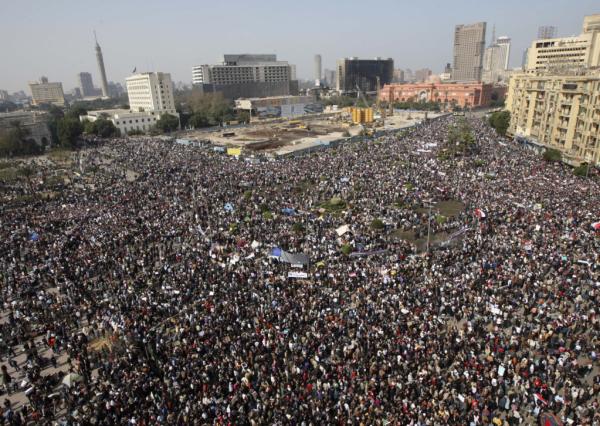
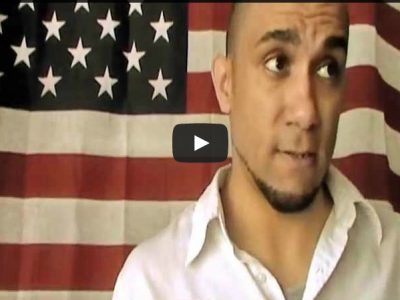
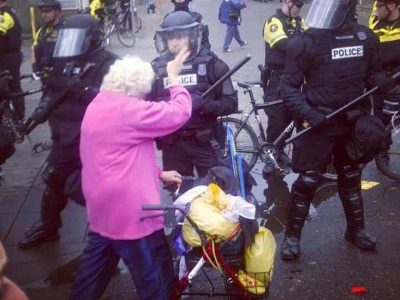
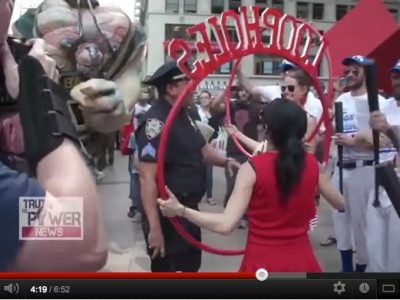
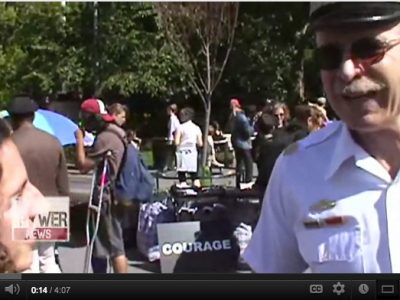
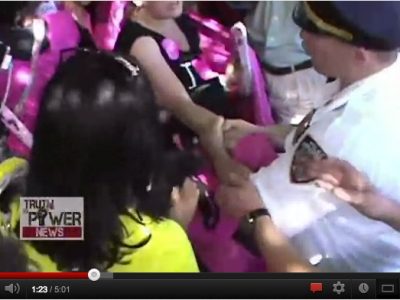
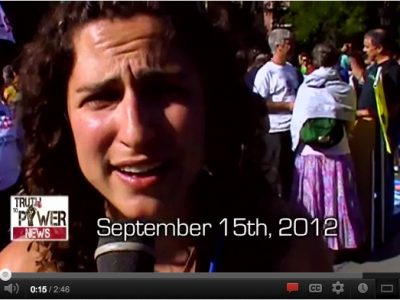
1 comment for “The False History and Misunderstanding of “Non-Violence””